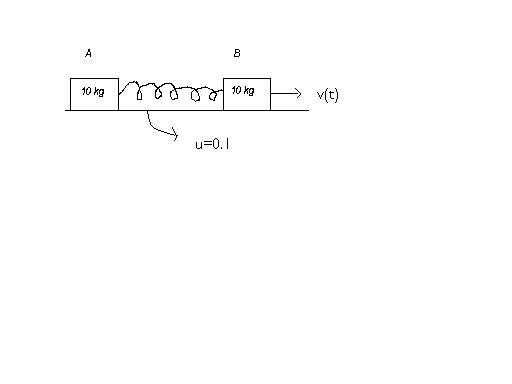sry abt that.............
Two blocks A and B are kept on a rough surface of coefficient of friction u=0.1 . Block B is pulled with a constant time varying velocity v(t)=0.1t . Spring constant is k=100 N/m.Then answer the following :
1. Work done by spring force on Block A till t=1 sec
2. Work done by spring force on Block B till t=1 sec
3. Work done by friction on Block A till t=1 sec
4. Work done by friction on Block B till t=1 sec
-
UP 0 DOWN 0 0 8

8 Answers
In the diag uve shown that B is pulled with vel v(t) while in the ques, uve mentioned it is done with A.. clarify this
uve to assume that the spring is initially at natural length and it is pulled with v(t)
havent given it much thought though
@ karna wat about the kinetic energies of d blocks ?? actually i solved it ..but waiting for oders
y is it zero?? and if the KE of oder is wat u said ....wy u didnt include it in ur equation above??
suppose x is the extension of spring
for A to move ...kx > uN
i.e x > uN/k i.e x > 0.1 x 100/100
x > 0.1 .........(1)
now at any time sb -sa =x...(2) where s = displacement
sb = ∫vbt = 0.1t2/2 = t2/20
at t =1 sec ....
sb = 0.05 ....(3)
frm (1),(2),(3)
0.05 - sa = x ........... (3)
now sa cannot be negative ..so max value of x in 1st sec =
0.05 ..wich is less dan 0.1 ..so A doesnt move ..so sa = 0
so x = sb = 0.05 m
so work done by spring on B
= - 1/2 kx2
= - 100 x 0.05 x 0.05/2
= - 0.125 J [ -ve bcz spring force and dsiplacment are in opp direction]
work done by friction = f.sb = - 0.1 x 100 x 0.05 =- 0.5 J
since displacement of A = 0 , work done by spring and friction on A= 0
more elaborated ..LOLZ by the way karna ...work ka unit Newton kabh se hua ?? lol